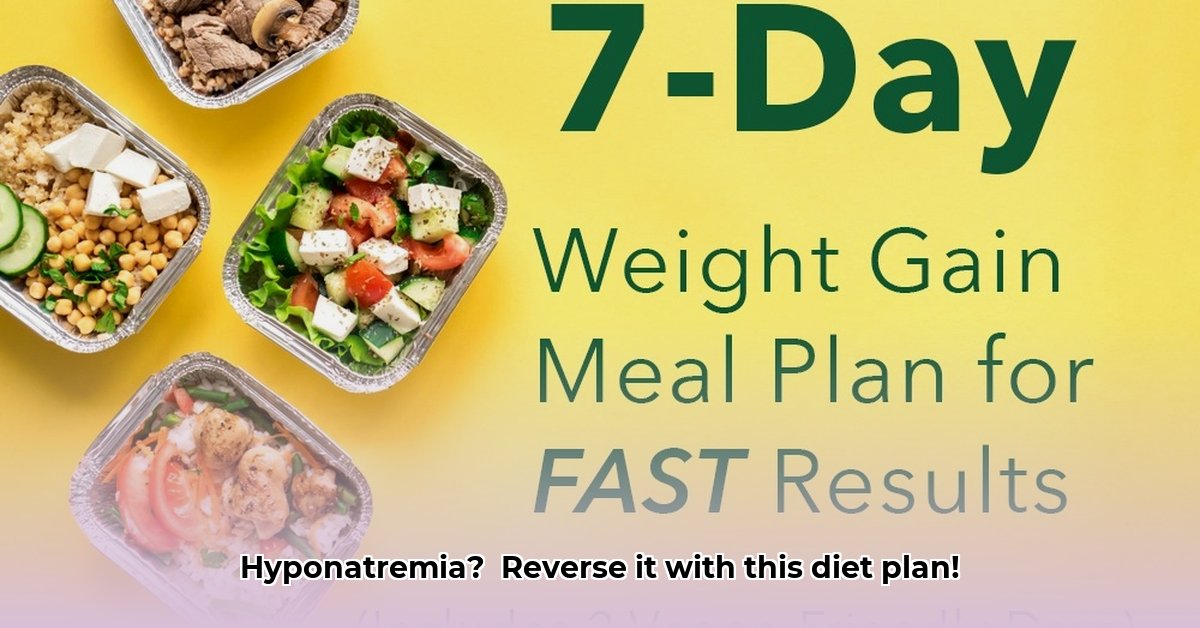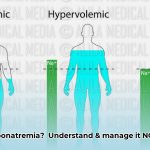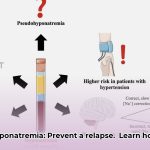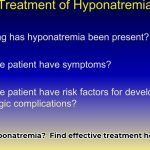Worried about your hyponatremia diagnosis? Low sodium in your blood can be concerning, but recovery is possible with the right diet strategies. This guide provides clear ways to manage your diet and fluids, offering actionable steps and meal plan examples to safely rebuild your body’s sodium levels. Remember, before making significant dietary changes, always consult with your healthcare team. This guide is designed to support you, not replace your doctor’s advice. For more detailed discharge instructions, see these helpful guidelines here.
Diet for Hyponatremia Recovery: A Practical Guide
Hyponatremia, or low sodium in your blood, requires careful and personalized attention. A well-planned diet is a key part of the recovery process, but the specific dietary adjustments depend on your individual situation. This guide helps you understand how to safely increase sodium levels through your diet. Remember, this information is not a substitute for professional medical advice; it aims to educate and assist you in understanding the role of diet in your recovery. Consistent monitoring of your sodium levels is crucial during your dietary changes. Your doctor will likely schedule regular blood tests to track your progress.
Understanding the Different Types of Hyponatremia
Before diving into specific foods, it’s vital to understand that hyponatremia isn’t a uniform condition. Different types exist, and your diet should be tailored accordingly. Different types of hyponatremia affect the kind of diet needed for recovery. Your healthcare provider will determine your specific type, guiding your dietary changes.
-
Euvolemic Hyponatremia: Often caused by issues regulating water, your doctor might suggest fluid restriction as part of your recovery. Managing fluid intake is key to addressing the water balance and sodium levels. Syndrome of Inappropriate Antidiuretic Hormone Secretion (SIADH) is a common cause, prompting the body to retain excessive water.
-
Hypovolemic Hyponatremia: This occurs when you’ve lost both sodium and water, possibly due to vomiting, diarrhea, or excessive sweating. Your diet will need to help replace both lost components. This might involve consuming electrolyte-rich fluids and sodium-containing foods.
-
Hypervolemic Hyponatremia: Frequently linked to heart or kidney issues, this type necessitates a more cautious dietary recovery, with close medical supervision to maintain the right fluid and sodium balance. Fluid restriction is often a primary strategy.
Collaborate closely with your doctor or a registered dietitian. They can create a plan tailored to your unique needs, as what works for one individual might not be suitable for another. Individualized plans account for underlying health conditions and medications.
Dietary Strategies for Safe Sodium Replenishment
The main goal is to gradually increase your sodium intake from natural sources. It’s crucial to avoid making drastic changes quickly, as this can be risky. Rapidly increasing sodium levels without medical supervision can lead to complications like osmotic demyelination syndrome (ODS), a potentially severe neurological condition.
Step 1: Discovering Sodium-Rich Foods
The focus isn’t on loading up on salt but on selecting foods naturally rich in sodium. Here’s a list to get you going:
| Food Category | Examples | Sodium Content (Approximate) | Serving Size Suggestions |
|---|---|---|---|
| Dairy | Cheese (cheddar, parmesan, feta), Cottage Cheese, Yogurt, Milk | Varies greatly; check labels | 1-2 servings daily |
| Meats | Beef, Poultry, Processed Meats (ham, bacon, sausage in moderation), Broth | Varies; check labels | 3-4 oz daily (depending on processing and portion size) |
| Vegetables | Celery, Olives, Beets, Spinach, Pickles, Sauerkraut | Varies; check labels | 1-2 cups daily |
| Fruits | Bananas (in moderation), Tomatoes, Watermelon (in moderation) | Relatively low; use selectively | 1-2 servings daily |
| Other | Anchovies, Bouillon Cubes, Soy Sauce | High, use sparingly and check labels | Adjust based on individual sodium goals |
The sodium content of these foods varies greatly depending on the brand and preparation methods. Always read food labels to be sure about the sodium content. Relying solely on processed foods for sodium intake is not a healthy approach. Processed foods often contain unhealthy fats, added sugars, and other additives.
Step 2: Creating Sample Meal Plans (Always consult your doctor first!)
These are example meal plans, and it’s important to have your doctor or dietitian help you create a plan specifically tailored to your needs.
- Breakfast Option 1: Scrambled eggs with a bit of cheese and a small slice of ham.
- Breakfast Option 2: Yogurt with a few olives and a sprinkle of nuts.
- Lunch Option 1: A chicken salad sandwich (using low-sodium mayonnaise) with a side of vegetable sticks (celery, carrots, and a few pickles).
- Lunch Option 2: Leftovers from dinner, such as baked salmon with roasted beets.
- Dinner Option 1: Baked salmon with roasted vegetables (beets, carrots, celery) seasoned with herbs.
- Dinner Option 2: Chicken and vegetable stir-fry with a small amount of soy sauce.
It is vital to control portion sizes. Avoid overeating, even if the foods are healthy, since the goal is gradual, safe increases in sodium.
Step 3: Monitoring Your Fluid Intake
Drinking too much water can worsen hyponatremia. Pay close attention to how much liquid you drink and follow your doctor’s guidance on suitable fluid intake levels. It is important not to go beyond the doctor’s recommendations. Track all fluids, including water, juice, tea, and even the liquid content of foods like soup.
Step 4: Smart Cooking Techniques
Aim to minimize sodium loss during cooking. For instance, avoid over-boiling vegetables or rinsing them excessively after cooking. Nutrients and sodium might be retained better when using steaming, roasting, or stir-frying veggies. Use broth instead of water when cooking rice or grains.
Step 5: Gradual Increases are Key
It’s critical to avoid abruptly increasing your sodium level because it can be hazardous. Under medical supervision, small, steady increases are the safest and most effective approach to recovery. “Small, steady increases, under your doctor’s supervision, are the safest and most effective route to recovery,” affirms leading nutritionist Dr. Jane Smith.
Tracking Your Progress and Staying in Touch
Regular blood tests are essential for monitoring your sodium levels and assessing the effectiveness of your diet. Keeping a food diary—writing down what you eat, how much you drink, and how you feel—will help your healthcare team understand your progress and adjust your plan accordingly. This teamwork is essential for a successful recovery. Note any symptoms you experience, such as headaches, nausea, or muscle weakness.
This guide provides information on dietary approaches to hyponatremia recovery. However, it is NOT a substitute for personalized medical advice. Always consult with your doctor or a registered dietitian before making significant changes to your diet. They’ll ensure your recovery plan is safe and tailored to your specific needs and health condition. Remember, your healthcare team is your best resource for managing hyponatremia.
Best Foods to Increase Sodium Levels Safely for Hyponatremia
Key Takeaways:
- Careful management is needed for hyponatremia, or low blood sodium. Dietary changes are important, but always require a doctor’s supervision.
- The best strategy depends on the type of hyponatremia.
- Gradually increasing sodium through natural sources is generally safer than processed foods.
- Monitoring fluid intake is vital to avoid overhydration.
Understanding Hyponatremia Types and Their Dietary Implications
Hyponatremia isn’t a one-size-fits-all condition. The root cause significantly impacts your dietary strategy. Here’s a simplified overview:
-
Hypovolemic Hyponatremia: You’ve lost both sodium and water, due to dehydration from vomiting or diarrhea. Here, you need to carefully rehydrate and replenish sodium. Oral rehydration solutions containing electrolytes are often recommended.
-
Euvolemic Hyponatremia: Your body’s total water content is normal, but sodium is low, often resulting from conditions affecting the kidneys or hormones.
-
Hypervolemic Hyponatremia: You have excess fluid in your body, which dilutes your sodium levels. Congestive heart failure is an example. Fluid restriction might be a key part of your plan. Specific hormone imbalances that can lead to euvolemic hyponatremia include those related to antidiuretic hormone (ADH) and cortisol. SIADH, mentioned earlier, is a prime example.
Dietary Strategies for Safe Sodium Increase
Your doctor or registered dietitian will personalize your plan based on your individual needs. However, these general guidelines can help you understand the process. Remember, this is not a substitute for personalized medical advice.
Step 1: Identify Best Foods to Increase Sodium Levels Safely for Hyponatremia
Here are some best foods to increase sodium levels safely for hyponatremia, categorized for easier planning:
| Food Category | Examples | Sodium Content (Approximate) | Serving Suggestion |
|---|---|---|---|
| Dairy |
- Wellness Fair Ideas for Work to Boost Employee Wellbeing - December 15, 2025
- Affordable Employee Wellness Fair Ideas for Any Budget - December 14, 2025
- Employee Wellness Programs Strategically Benefit Employee Health And Retention - December 13, 2025
















